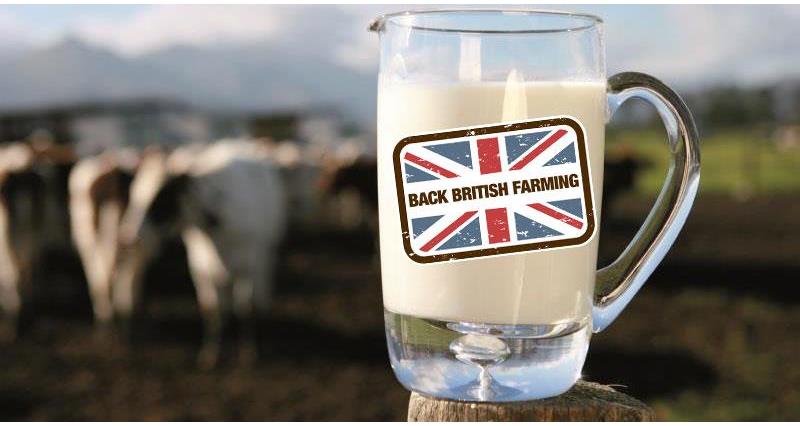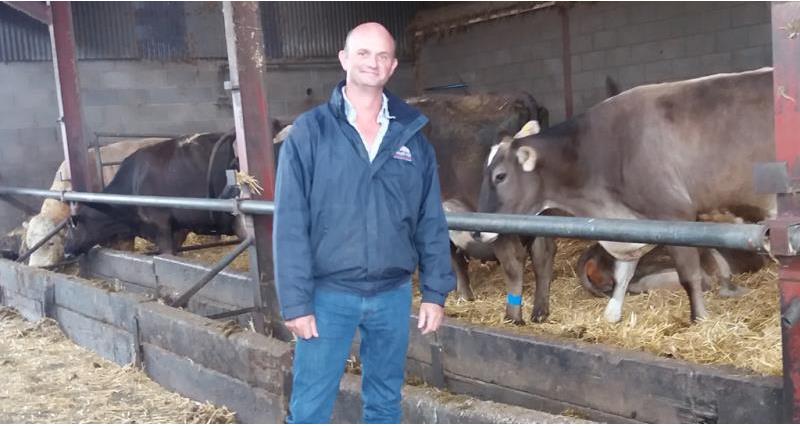About the industry
Dairy farming is the production of milk mainly from cows, but also sometimes from goats and sheep. Milk is then bottled into fresh liquid milk or processed into a wide variety of products including cheese, butter, cream, yoghurt, whey protein and infant milk powder.
A British dairy farmer’s number one priority is keeping their animals happy and healthy, both from an animal welfare point of view and from an economic perspective, as cows are more productive when they are happy and relaxed. Farming is a 24/7 job with cows normally milked twice or three times a day, and many dairy farmers milking a part of their herd every day of the year.
After calving for the first time, the heifer joins the dairy herd and is from then on called a dairy cow. A few months later the cow will be put in calf, and around two months prior to their next calving, the cow will be taken out of the dairy herd, dried off, and given a break (“the dry period”) before calving again, and the cycle repeats.
The day starts with the morning milking, which could mean the farmer may first need to collect the cows from their field, or let them out of their barn. They take it in turn to be milked after which they return to a new grazing field or a clean, freshly bedded barn. There they eat, drink and ruminate before being collected for milking again in the afternoon for the second milking, when the cycle repeats.
As well as being involved with milking, dairy farmers are also required to manage grassland, rear calves, score the cows for body condition and movement and manage breeding through choosing specific breeding programmes for each cow and also by completing the artificial insemination themselves. During harvest time many dairy farmers are busy cutting and conserving forage (grass, wheat, maize, barley etc.) to provide winter feed. The busiest time on a dairy farm is the calving and mating period, especially in herds that calve all their cows together in the Spring or Autumn.
Most dairy cows you’ll see in the UK are the black and white Holstein-Friesian breed. This is a cross between the Dutch Holstein breed and the British Friesian breed. This cow is bred specifically for milk production but also longevity, good feet and ease of calving. You’ll also see many channel island cows in the UK – mainly brown Jersey and Guernsey cows and these produce a creamier milk.
Dairy cows are bred specifically for milk and look quite different from beef cows. They tend to stand taller and look far more boney and angular because they are bred for milk production, while beef cows are bred for beef production, and therefore have a stockier build.
British dairy farms are extremely diverse in size and structure. Herd sizes range from around 50 cows to over 1,000 cows. As of 2016, the average herd size in England was 148 and 142 in Wales. No matter how big or small a dairy herd is, the health and welfare of the cows is of paramount importance to British dairy farmers and is not impacted by the size of the herd.
There are 9,282 dairy farms in England and Wales, milking 1.84 million dairy cows and producing a total of 14 billion litres of milk a year.
Sector and economy
To help British dairy farmers you can buy British milk, cheese, yoghurt, butter and ice cream. Look out for the Red Tractor logo on packaging as 95% of milk produced in the UK is Red Tractor assured. This means milk is produced on farms that are independently inspected to high animal health and welfare, environmental and food safety standards. The Union Flag on the logo ensures traceability by guaranteeing that the product can be traced back to a UK farm.
Find out for yourself about the fabulous work British dairy farmers do producing our food and managing the countryside by visiting a farm for Open Farm Sunday 2019.
As a rough estimate the dairy industry in the UK provides jobs for 70,000 people. The majority of dairy farms are family farms, employing mainly family labour and relief milkers. Larger dairy farms will employ specialist staff for animal health, nutrition, breeding and foot trimming. The rough estimate is that 1 person can manage 50 cows, so the larger the herd the more staff you will require.
As well as on-farm staff, dairy farmers support a wide network of wider dairy industry staff including veterinary surgeons, feed merchants, tanker drivers and hauliers, milk processors, foot trimmers, dairy consultants and farm secretaries.
Dairy and animal welfare
The majority of British dairy cows spend the spring and summer months grazing outdoors and spend the cold, wet autumn and winter months housed in large, open barns. Some cows remain indoors for the majority of the year and may spend their dry period (rest period prior to calving) at grass. The main reason for housing cows indoors is the inclement weather we experience in our winter period which means that grazing is difficult – both because of the lack of grass growth and the risk of damaging the land. Additionally, housing cows can allow the farmer to keep a close eye on their herd, pick up any ailments early on and can increase milk yield.
While indoors cattle are provided with all their needs – from comfortable beds (from cow mattresses, to deep sand beds, to soft sawdust), ad lib food and water, socialising areas called loafing areas and toys such as fans, sprinklers and cow brushes. Barns are often split into sections which provide cows with the space to exercise and socialise as well as areas which contain comfy cow cubicles where they can lie down to rest. Some farmers choose to fit their cows with pedometers to ensure they are getting enough exercise – similar to the step-counting apps many of us download onto our phones.
Barns are sometimes fitted with cow brushes which allow the cows to rub up against them, scratch an itch and remove any dirt or loose hair. This helps to improve the health and comfort of the cows. Grass is often cut and brought inside in bulk to be fed to the cows. The light, airy, well ventilated barns create an environment that protects them from the elements, be it wind, rain or sun. Many farmers fit large fans into their barns to aid ventilation and a healthy air flow.
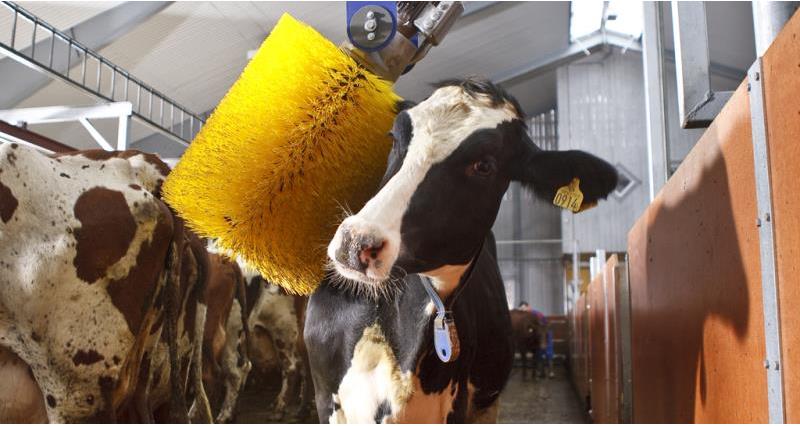
While cows enjoy being out in fields, just like us they enjoy coming inside when the weather isn’t in their favour. A dairy cow that has regular access to food and water, a place to rest and the ability to socialise with other cows is a happy cow. Whatever system of housing is used, compliance with the Assured Dairy Farms (ADF) scheme requires all dairy farmers to ensure their buildings and management systems enable their cows to enjoy the Farm Animal Welfare Council's 'Five Freedoms' that define good welfare.
British dairy farmers care about the comfort of their animals and the design of cattle housing is carefully considered for their needs. Hutches, also known as individual stalls or pens, are seen by veterinary experts as one of the best systems for rearing young calves before they are moved into groups. Calves are born with little natural immunity so calf hutches are used as a clean, safe environment where calves can receive specialist care to ensure they reach peak condition in a protected environment.
Calves can be kept in hutches until they are eight weeks old but may be moved out earlier if the farmer is happy with their health and growth and they are consuming the right amount of feed. Hutches comply with all welfare requirements and allow the essential social contact calves need without risk of bullying. The Red Tractor dairy standards state that the hutch should provide them enough room to stand up, lie down, turn around, stretch and groom.
Done well and to a high standard, this approach is recognised as offering the best start for calves through a warm, safe and social environment with individual care. This aim is for better health and effective biosecurity.
As soon as a cow has had her first calf, she will start producing milk. How a cow is milked depends on the type of milking system the dairy farmer has. The most common milking system is the herringbone parlour – typically this consists of a dropped floor where the farmer stands whilst the cows line up on either side. The farmer goes along each line cleaning the teats before attaching the clusters. The clusters gently massage the teats to stimulate milk flow just like a calf. Once milk flow reduces sufficiently the clusters will either drop away automatically or are removed by the farmer. Some clusters will first dose the teat with iodine or another form of disinfectant to help avoid infection. If not the farmer will go along the line and administer this to each teat individually. Once both lines are milked the cows are walked out of the parlour, the clusters are washed and the next cows filter in. Most farmers milk their cows twice a day, normally at 5am and then at 3pm-4pm in the afternoon – the nearer the 12 hour gap the better for milk production. Some farmers will milk their most productive cows three times a day.
Another type of milking system is a rotary parlour. Cows walk onto a circular raised platform, allowing the farmer to attach the milking cluster from below. The platform rotates very slowly, allowing cows to enter and exit the platform at intervals.
An increasingly common way of milking cows is though robotic milking. This allows the cow to choose when she wants to be milked. Since the robots are normally situated indoors cows which are milked robotically are often housed indoors. Unlike the robots we may be used to, the robotic milking machine itself doesn’t move, with cows enticed into the robot through the provision of food, or the need to be milked.
When the cow enters the milking area it is identified by an electronic tag, pedometer or “necklace”. If a cow has been milked too recently it will be released from the robot without being milked – some cows decide to enter the robot just for food. If the cow is due to be milked, each teat is first cleaned and disinfected, before a laser beam detects the position of the teats and connects one milking cup at a time. The teats are massaged gently as the cow is milked. During this time, the cow will be fed. Each cow has an allotted amount of feed from the robot for each day. Once milked, the teats are cleaned and disinfected again before the gate reopens allowing the cow to exit the parlour.
A cow will not let her milk down unless she is fully relaxed and at ease in her environment. Cows associate milking parlours with a sense of release from milk in their udders and therefore it is a relaxing time. They will draw willingly towards a parlour as it nears milking times.
When grazing cows get most of their nutrition from grass, with a top up feed at milking. Indoors and over the winter period cows will be fed a diet developed to suit their individual needs, depending on their stage of lactation. Typically a farmer will feed their herd a mixture of wheat, barley, maize, maize gluten, oil seed rape, soya, brewers grains, palm kernel and other alternatives as part of their balanced diet.
For several reasons, be it culture, history or nutritional benefits, 98% of the public consume dairy products. It is therefore essential to have a national dairy herd to serve this demand for home-grown dairy produce. Farmers and vets work together to find the best way to do this from a welfare perspective.
Experts recommend that calves are separated from their mothers as soon as possible, as this minimizes stress to mother and calf. The mother is returned to the main herd to eat and recoup energy after calving. Many dairy farmers raise their calves in a special area of the farm, where they are given additional dedicated care to ensure they reach peak condition in a protected environment. During the first 24 hours, newborn calves are fed colostrum, as this provides essential antibodies to protect them against illness or disease.
Calves continue to receive milk for several weeks after birth. During this time they are gradually introduced to other foods, with nutritionists and vets helping the farmer to develop a diet plan suited to the calves' age and size. After weaning, female dairy calves are generally reared to join the milking herd.
Another key reason for keeping calves separate from the herd is to reduce the risk of illness whilst they are building their immune systems. The risk of pneumonia is greatly increased if calves are kept with a mix of animals of all ages. It also prevents the calves from being trampled or bullied by other adult cows.
Red Tractor Farm Assurance requires farmers to follow recognised and independently inspected standards of calf health and welfare.
Generally, female calves are reared to join the milking herd as replacements or are sold on to other dairy farms. Bull calves provide an extra source of income for dairy farmers and it is estimated that over 80% of male calves born in the UK enter into the beef market. This can be as young beef, generally rose veal in the UK, or as more mature finished beef. Rose veal shouldn’t be confused with white veal which is reared on the continent. White veal is banned in the UK on welfare grounds. Calves reared for “young beef” are often between 8 and 12 months old when they enter the food chain.
Farmers do all they can to ensure they breed the right calves for their farming system. For example many dairy farmers now use sexed semen (up to 60% of those surveyed in a recent NFU survey) to inseminate heifers (young female cows). Using sexed semen in a dairy herd ensures that the calf born is female. Other cows are mated to beef bulls or inseminated with beef semen, which then ensures that the calves born are more beefy in stature, and are suited to the beef supply chain.
Where rearing for beef or rose veal isn’t possible, and there is a risk of overcrowding on farm, some bull calves are euthanized. This is never a decision taken lightly. The marketing options for bull calves on TB restricted dairy herds are particularly limited. Raising a male calf that will not have the opportunity to go on to be a productive beef animal is not something that farmers want to do, it is unfair on the animal and unaffordable for farmers.
The industry is actively working to reduce the number of non-viable male calves born into the supply chain and create sustainable markets for them.
Dairy farmers are committed to keeping their cows happy and healthy. Just like you, sometimes cows need a little helping hand to treat or prevent disease. To ensure animal welfare and safe food supply, vets can prescribe antibiotic treatments. Milk from cows receiving antibiotics does not enter the food chain and there is a strict withdrawal period for milk and meat.
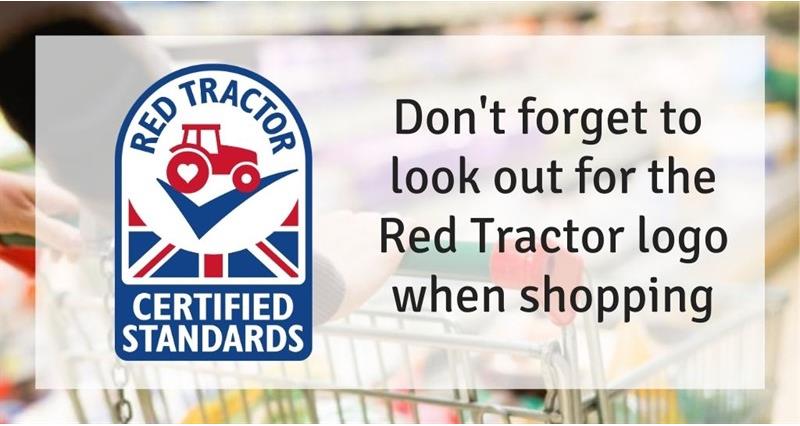
Food
Dairy products are highly nutritious with milk, cheese and yoghurt all containing high-quality protein, calcium, B vitamins, iodine and potassium. According to medical experts, young children should drink full fat milk (which has 3.5% fat), whilst school aged children and adults are advised to drink semi-skimmed milk (only 1.7% fat). This makes dairy foods an important part of overall health and a balanced diet. Eating these foods improves bone health, especially in children and teenagers, and provides a balanced package of essential nutrients. Currently 98% of the UK population regularly eat dairy products.
Raw milk is the term used to describe milk sold as it is straight from the cow. Milk for sale in retailers is pasteurised and processed Raw milk can only be purchased direct from the farmer. Sales of raw drinking milk are prohibited in Scotland. Around 200 dairy farmers in England sell raw, or "green top" milk directly to consumers, either at the farm, at a farmers' market, or through a delivery service. The bottle must display a health warning.
Dairy and the environment
Dairy farmers take great care and pride in protecting the environment through responsible use of fertilisers and careful management of hedgerows to allow wildlife to flourish. Much of this is recorded in the Dairy Roadmap which has set environmental targets for the UK dairy industry (from farm to retail) for 2020 and 2025. British dairy farmers in particular have worked extremely hard for almost a decade to reduce their environmental footprint and as a result greenhouse gas emissions from UK dairy farms have declined sharply over the last 20 years. This has mainly been through increasing efficiency and yield per cow.
Dairy Environmental Wins
- 90% of dairy farmers are actively nutrient management planning – good nutrient management can bring a number of important benefits including minimisation of greenhouse gas emissions, reducing the incidence of diffuse water pollution and optimising farm efficiency.
- The Dairy Roadmap found in 2013 that 69% of dairy managed farmlands were in an Environmental Stewardship Scheme – this demonstrates the excellent work already being completed on farm, including hedgerow management, protection of habitats and lowering inputs on grassland.
- The Roadmap set the target for a 70% uptake in water efficiency methods - British dairy farmers are looking to conserve water and cut costs without compromising animal welfare or dairy hygiene. In 2012 78% of farmers were implementing water efficiency methods, of these 30% collected rain water, 94% re-used water from a plate cooler and 53% diversified water supplies using a borehole.
- 78% of dairy farmers are currently taking action to reduce the GHG emissions on their farm – this is higher than any other farming sector.
Yes. In 2014 one-third of farmers in England and Wales were generating renewable energy – out of over 500 farmers interviewed, dairy farmers made up 10% of respondents. The industry has continued to improve and expand on this target through methods such as solar PV panels, wind turbines and anaerobic digestion which allow dairy farmers to produce renewable energy from cow manure and various crops.
Meet the dairy farmer
A series of on-line articles introducing dairy farmers, seeking to explain what they do and the efforts they go to producing quality British milk.
Abi Reader, South Wales
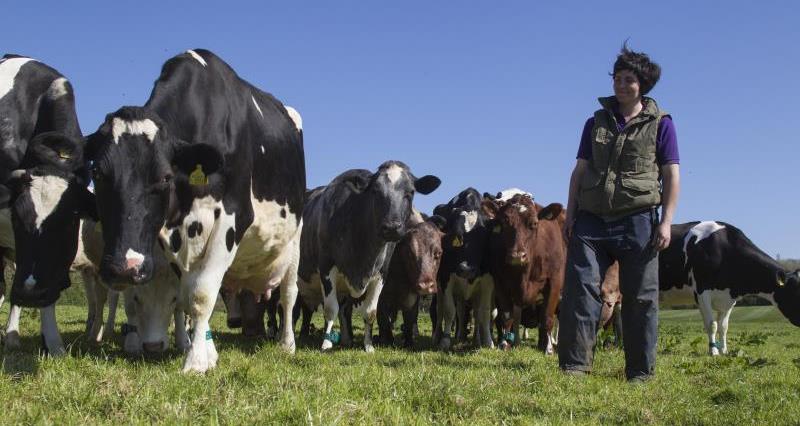
I am a third generation dairy farmer and farm alongside my father and uncle on 800 acres in Glamorgan. Dairy farming is in my blood. We currently have 90 Holstein Friesians and 90 Dairy Shorthorn, which is a rare native brown and breed that was very popular pre-World War 2.
We tend to have 15 new born calves each month and calve all year round. We rarely have to assist with calving, maybe 8 – 10 cases a year. Once the cow goes into labour she is monitored all the time, but we only interfere if we feel it is necessary and the cow is in distress. Once the calf is born its mum is given a bucket of warm water to drink as she’s usually really thirsty. The calf is licked off although not all cows do this and given a bottle of colostrum to get much needed nutrients into it immediately. If it’s winter a coat is put on the calf to keep it warm as understandably they feel the cold. We aim to give the calf 3 litres of rich colostrum milk in its first six hours of life so it has the right protection. Due to a young calf’s vulnerability it is essential to ensure they get the colostrum they need early on, a farmer’s intervention is required to ensure the calf isn’t sucking futilely and getting weaker rather than gaining strength in those early hours.
The instinct of a young calf is to lie down and hide, to keep the calf safe we put them into a single pen in a shed next to the main cowshed, where other calves are housed. They stay in a single pen for their first week before moving into a small group of similarly aged calves to learn to be part of a herd and socialise. The calf drinks its mother’s milk for the first week then herd milk until it is weaned at approximately 8 weeks, their milk is always served warm. The calf is fed twice a day.
Meanwhile the cow, once it has had a much needed warm drink is fed with a hay based diet of maize and silage before being milked after about 12 hours. The milk which contains the valuable colostrum is saved for new born calves and their milk is given to their calf for a week before the normal milking regime recommences. The cow enjoys being milked after birth to have the pressure taken off their udder after the sudden milk flush of calving.
Both bull and heifer calves are treated the same way in their first weeks of life. Young calves are vulnerable, to bugs and infection but also to adult cows, who due to their clumsiness can without intention lie on them and can sadly pass on infections, which adult cows have built resilience to. Even a simple stomach upset can kill a young calf, this is one of the reasons the calves are housed separately after birth.
Our husbandry practices have been developed over many years, taking account of our experiences and ensuring the needs of the cows and their calves are met. Our calves have a warm, safe and social environment in their early weeks of life with individual care.
Phil Latham, a dairy farmer from Cheshire
Four generations of my family have farmed at our farm near Nantwich in Cheshire, we also have a second unit at Tarporley. We currently have 450 pedigree Brown Swiss cows and we operate a closed herd, which means we breed our own replacements and haven’t had to buy in young cows for 21 years.
We have a team approach to good cow husbandry with our staff, nutritionist and vet. Our healthy cow strategy was developed back in 1996 and aims to make positive nutritional decisions to ensure our cows receive exactly the right amount of feed, which means they enjoy a healthier, longer life. We chose to breed Brown Swiss cows because they provide the vigour of a hybrid combined with being a good milk producer. We used to have Holsteins (the classic black and white dairy cow) who typically yield 45-48 litres per cow per day, but feeding them to meet their metabolic requirements at peak yield meant we had to keep them indoors. With the Brown Swiss they produce 38 -40 litres of milk per cow per day, and they can be out on grass for longer. Our farm is good at growing grass.
Like most farms we have routine vet visits and our herd health has a huge emphasis on nutrition and meeting the cow’s needs. Milk yields are measured every day with digital weigh scales and the dairy parlour software enables us to produce yield measurements by group for all milking cows. We carefully monitor health characteristics and adjust the nutrition accordingly.
Dairy farming is a massively high-tech sector and we use a huge amount in the care and welfare of our herds. For instance, every cow has an auto ID tag apart from those that are pregnant who wear a silent monitoring collar to measure activity. We also use inter-herd software to keep our cow records for all parameters including health characteristics, movements and medicine records. We work with a vet to measure any illness within the cows, factor in any cost to the farm and set targets to reduce any incidence.
Our herd tends to calve all year round. We monitor the cows’ body temperature, which is done five times a day, to check when they are ready to be serviced by a bull. For the cows that are already in-calf we check on those every night to ensure their health and wellbeing. After a cow has calved we are quick off the mark to separate cows and calves because we want to optimise their welfare and ensure that the calves get the right levels of colostrum soon after birth. This is hugely important because colostrum is the first milk from the mother and contains antibodies to protect the new-born against disease. A calf’s immunity is assessed using something called ZST test which measures their vitamin and mineral levels to ensure that the right colostrum level is attained. A lack of this in the early stages of a calf’s life can result in health problems later on. Our females go into the herd and all of our bull calves are sold to other farms where they are reared for beef.
All dairy cows come indoors to barns for the winter to avoid the harsher weather and on this farm we aim to turn them out to pasture at the end of February and then they stay grazing the fields until early December. While in the field we use something called Aginet software to optimise grazing quality and ensure there’s a sufficient quantity of forage for the period ahead to meet the cows’ food needs. Everything we do is geared towards their health, welfare and making the farm as efficient as possible.
John Torrance, a dairy farmer from Essex
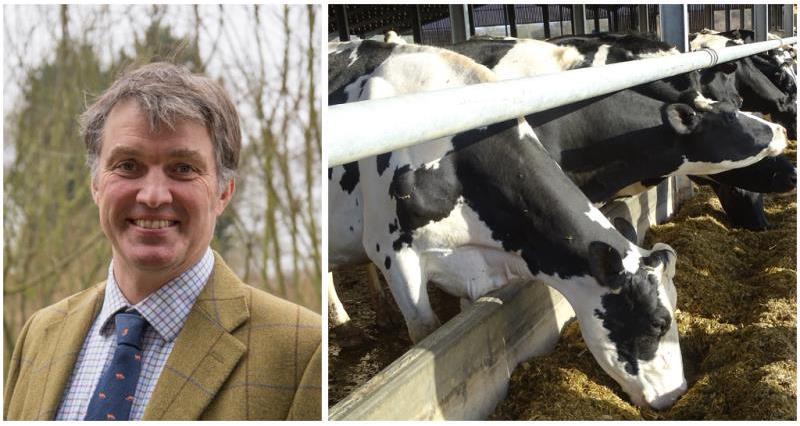
I am the third generation of farmers in my family. My grandfather moved down from Scotland in the 1920’s and took up a Crown Estate tenancy. I then followed in the footsteps of my father. Our farm is one of the few farms within the M25 near Romford and is only 15 miles from central London.
Our dairy herd consists of 500 Holstein cows and we employ eight full time staff to help run the farm and ensure our cows are professionally looked after. We operate an indoor system as experience over the generations has shown that we can’t rely on adequate quality of grass for our cows due to the dry conditions we experience in this part of Essex. Our milk yields have to remain the same all year round in order to meet our milk supply contract, which would be impossible if we relied on outdoor grass feed all year round.
Our cows are housed in a large barn, which is well lit and airy. The cows have two areas that they can use, the first is in the centre of the barn and is like a large sandpit, where the cows can lie down in comfort as the sand moulds around their body and the other area, which covers the whole outer area has rubber matting covering the floor, where they can mix and mingle with their other herd mates. The cows have free access to fresh water and food and can roam between areas.
The welfare of our cows is crucial as without a relaxed and healthy herd we wouldn’t get the milk yields that enable us to have a reliable business. We milk the cows three times a day in a separate parlour. Every time the cows are milked the barn is cleared and cleaned so the cows always return to a clean environment. The cows’ dietary needs are met by a nutritionist who advises us on the best feed to meet all their dietary and health requirements. Their daily feed includes freshgrass, maize silage and wheat, much of which is grown on our farm.
The way we farm has been developed over many years and we are proud of our dairy cows and our husbandry standards.
